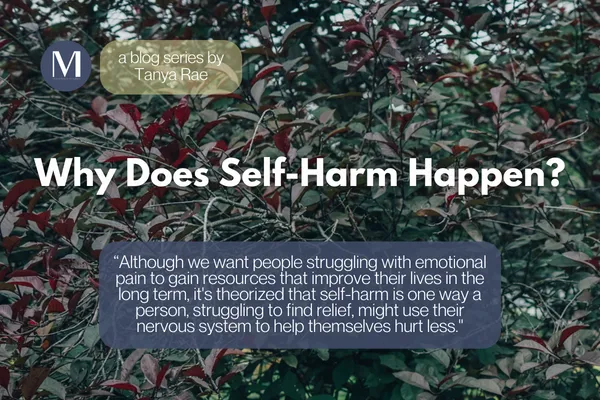the blog
A place for our team to share about topics they are passionate about, in hopes of allowing you to see and understand a bit more behind the faces on these pages.

Why Does Self-Harm Happen?
Whether you are new to this blog series or not, I wanted to provide a trigger warning.
The topic of this post is suicidality. Please take care of yourself and skip this post if it's a triggering topic for you. Come back next time for a whole new topic!
When it comes to suicidality, another very stigmatized and related topic is self-harm. This may be because self-harm can sometimes be life-threatening, as it involves bodily harm, or because self-harm sometimes occurs when suicidal ideation increases. However, not all people who experience suicidal ideation also think about or engage in self-harm. I use "engage in self-harm" here because it is also a part of the automatic stress response, also known as the "fight or flight response," which has been explained throughout this series. We use our automatic stress responses to get out of harm's way or protect us from pain. Since there is stigma associated with self-harm that prevents people from seeking help to find better resources and because it seems to be linked with suicidality, I thought I would include it in this series to demystify its use by some.
In sessions with clients who have engaged in self-harm, I often hear that they don't know why they've done it, but it somehow helps. As explained in a previous post, physical and emotional pain are registered in the same area of the brain, which means emotional pain truly does hurt. What's interesting is that when we fall down and hurt ourselves, the body releases natural endorphins, a hormone that helps us feel more relaxed, think clearly, and reduce pain. So when a person intentionally hurts themselves, they're tapping into and "using" this natural pain-relieving response, which is a part of the automatic stress response, to immediately feel better from the intensity of the pain, even if just for a moment. It's a relief. A respite. Although it's not ideal, and we want people struggling with emotional pain to gain resources that improve their lives in the long term, it's theorized that self-harm is one way a person, struggling to find relief, might use their nervous system to help themselves hurt less. This is a logical explanation that demonstrates the resourcefulness of human beings who feel trapped in pain but also highlights the need for compassion, non-judgment, and more public knowledge. If you or someone you know is engaging in self-harm, be encouraged; there's a logical explanation for it, and it doesn't necessarily indicate a risk of suicide. Psychotherapy can help get to the root of things and provide coping skills that will improve life both in those difficult moments and in the long term.
Thank you again for following along with this series and your willingness to learn and create conversation around a very tough but important topic.
If this series has created questions or a desire to talk to someone, please know that there is a team at MCC who is ready and willing to help.
Til next time,
Tanya
Office Location: 1200 Brock Street South, Whitby, ON. L1N 4L9
© Marquis Counselling & Consulting | ALL RIGHTS RESERVED | TERMS & CONDITIONS | PRIVACY POLICY
